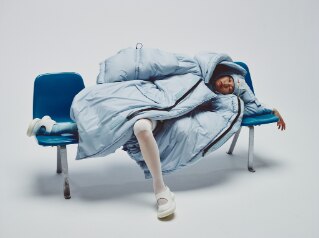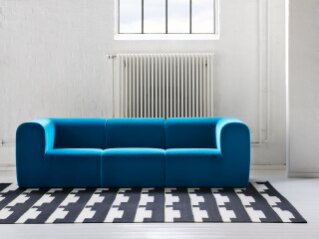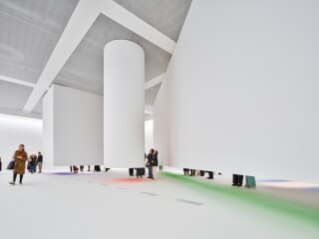If there’s one feeling that defines the arrival of the Salone del Mobile more than any other, it’s anticipation. That restless excitement, that feverish energy that builds in the days leading up to it, that desire where curiosity and expectation intertwine. Waiting for the Salone del Mobile is a ritual, a collective illusion, a wager on the future of design that renews itself with each edition.
Yet, just like in Samuel Beckett’s Waiting for Godot – the play that not coincidentally was staged by designers such as Italo Rota, Fabio Novembre, and Sandro Mendini during the Salone a few years ago – the design world, too, seems to find itself waiting – year after year – for someone or something that may have already arrived unnoticed or may never arrive at all. Still, the waiting remains, the silent protagonist, a suspended moment yearning to be filled with meaning.

Even Paolo Sorrentino, tasked with interpreting the Salone del Mobile 2025 through his own installation – much like David Lynch did last year with his Thinking Room – places waiting its heart. In what might carry an unintended sense of irony, he and Margherita Palli have envisioned a waiting room outside a cardiology clinic.
And when you think about it, it’s a fitting image: the Salone del Mobile as an endless wait, filled with anxious glances, uncertain hopes, hurried races – people anticipating something that may never come. A pounding heart, but more from stress than excitement.
A design where everything is possible, but everything feels useless.
Andrea Branzi

Perhaps I would have preferred a different Sorrentino. A Grande Bellezza 2, set at the Salone del Mobile. A Milanese rooftop – maybe at the Triennale, or perhaps the Torre Velasca or Terrazza Martini – offering the perfect vantage point to observe the colorful humanity of the design world: creatives at all costs, designer-stars with glasses bigger than their ideas, entrepreneurs nodding with an air of inspiration in front of pieces they don’t understand, journalists asking pre-packaged questions while sipping yet another spritz, influencers taking selfies with objects they’ll never use. All of them caught in feverish excitement, all hungry for innovation, all swept up in a kind of presidential bulimia that teeters between the sublime and the absurd.

But as Sorrentino’s camera captures this scene, I imagine the city itself beginning to transform. And in the meantime, another possible Salone takes shape: silent, electric shuttles whisking visitors from one location to another, seamlessly connecting Salone del Mobile and Fuorisalone – no more struggling with maps that look like Rorschach tests, no more trekking miles between neighborhoods linked only by initial enthusiasm and final exhaustion. A more thoughtful approach to the now-rampant overbooking of events (this year’s count is estimated at 1,600), a deliberate pause to the relentless race for “more”.
I’d like to raise a good-luck drink at the Stork Club where there’s no need to scramble for a spot in some contrived concept bar with an endless waiting list, where even the pretense of waiting for Godot has long since disappeared.

Why should design increasingly resemble an amusement park, one that leaves you with a headache rather than a clear vision of the future? A more curated selection, a smarter synergy between Salone del Mobile and Fuorisalone could help prevent that creeping sense of saturation and fatigue that – every year – inevitably sets in by the third day.
I imagine an interactive pavilion, one that fosters open, uncensored debate. A space where entrepreneurs, designers, architects, and philosophers can freely discuss the limitations and future of the field, without bending to market pressures or blindly conforming to the notion that everything is beautiful, and the most beautiful things are always the ones you didn’t get to see.
I dream of a park filled with chairs that talk to each other, chairs that rebel against designers who make them impossible to use. Chairs that dare to say, “I don’t want to be a work of art; I just want someone to sit on me without needing physical therapy afterward.”
Artificial intelligence is everywhere; yet too often, it manifests as intrusive, pointless, and downright irritating objects. [...] Is it too much to dream of a more subtle, almost imperceptible interaction?

In the 1960s and ’70s, design was a laboratory of utopias, a space for radical experimentation. Today, everything feels too predictable, too meticulously crafted for the sole purpose of being sold. As Andrea Branzi once said with sharp skepticism, “A design where everything is possible, but everything feels useless.”
Where have the dreams gone? Could it be that the Godot we’ve all been waiting for is, in fact, the return of the ability to dream? I dream of a Salone del Mobile that isn’t just a self-congratulatory, self-referential spectacle but a moment of reflection, an opportunity for design to question itself and its role in an increasingly uncertain cultural landscape.
I dream of a design world that moves beyond yet another chair with a high-sounding name and instead focuses on solving real problems – furniture that adapts to people’s changing needs, designed for evolving environments.
What about a table that extends on its own when you need more space? And an armchair that adjusts its ergonomics to match your mood? A carpet that shifts color based on room temperature? A system bold enough to admit that some so-called “eco-friendly” plastics are less recyclable than chewing gum on a paved road and that the real future lies in materials that regenerate, age gracefully, and perhaps even disappear when no longer needed.

Between Salone del Mobile and Fuorisalone, artificial intelligence is everywhere; yet too often, it manifests as intrusive, pointless, and downright irritating objects. Who really wants a chair that talks to them or a refrigerator that judges their sweet tooth? Is it too much to dream of a more subtle, almost imperceptible interaction? As in a bedside table that gently turns off the light when it senses you’re drifting off or a kitchen that suggests recipes based on what you have in the house without making you feel incompetent or clueless. Technology – yes, but with tact. And without stress.

More than anything, though, I’d love to see Reyner Banham resurrected for a masterclass on sustainable futures – the man who had it all figured out back in the 1970s. In three minutes, he’d tear apart the greenwashing of far too many brands, calling out with sharp, incisive words those who drape themselves in sustainability just to sell more green-painted plastic.
And finally, I’d like to raise a good-luck drink at the Stork Club – the masterpiece designed by Gianfranco Frattini in the late 1950s – bathed in soft lighting and timeless elegance, where there’s no need to scramble for a spot in some contrived concept bar with an endless waiting list, where even the pretense of waiting for Godot has long since disappeared.
Opening image: Tortona Design Week. Courtesy Fuorisalone

Franke presents “The House of Well-Living” at Fuorisalone
With a multi-sensory installation, Franke will welcome visitors to its flagship store during Milan Design Week and present the year's new products.










